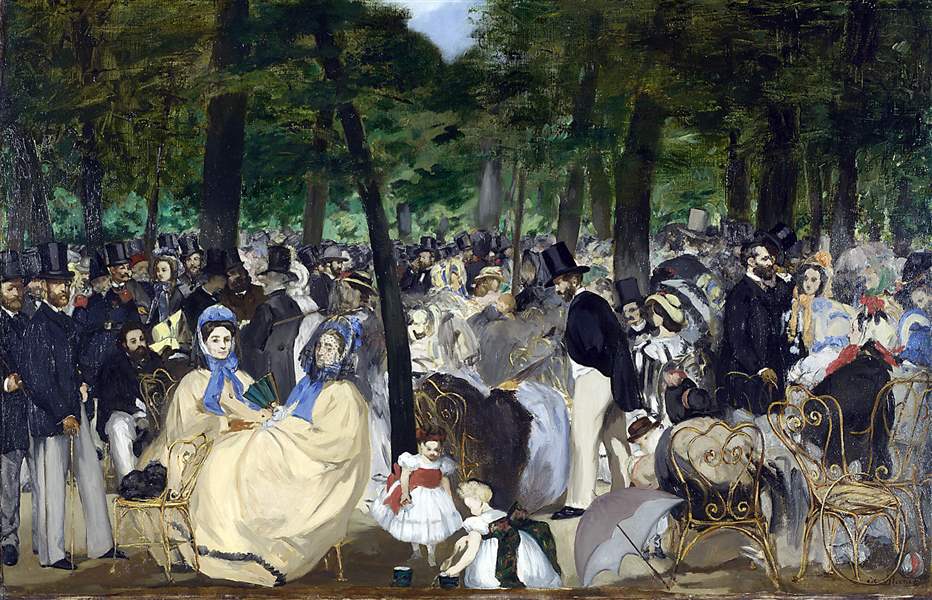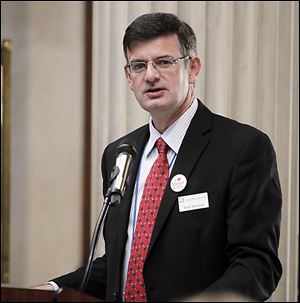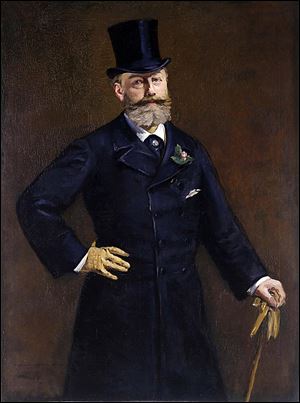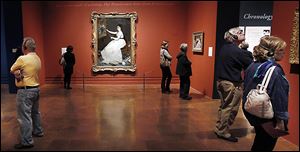
Toledo, London Manet exhibits not identical
Many paintings in exhibit appear at one of the art museums but not the other
2/11/2013
‘Music in the Tuileries Gardens’ is among the Manet works on display in London. The painting was not part of the earlier Manet exhibit in Toledo.

‘Music in the Tuileries Gardens’ is among the Manet works on display in London. The painting was not part of the earlier Manet exhibit in Toledo.

Toledo featured Manet’s ‘Chez le Pere Lathuille,’ of a couple at an outdoor cafe. A Belgian museum, the Musee des Beaux Arts, loaned it to Toledo to juxtapose with Toledo’s portrait of Antonin Proust, at right. ‘Chez le Pere Lathuille’ appeared only in Toledo, but the Proust portrait is displayed in London as well.
Edouard Manet’s painting Music in the Tuileries Gardens, depicting concertgoers gathered under trees, will hang in its own gallery for the next couple months at London’s Royal Academy of Arts.
The painting is among the highlights in Manet: Portraying Life, an exhibition at the Royal Academy that concluded its Toledo Museum of Art run on Jan. 1. But local art lovers must travel to London to see this particular painting, which features Manet, some of his family, and fellow artists.
The two institutions co-curated the exhibition, but the logistics of borrowing, transporting, and displaying prized art meant some pictures were shown at only one site. The gardens painting is one of about 18 in the exhibition to be shown only at the Royal Academy. Toledo exhibited roughly seven paintings not included in London.
Much of the art that appears only in London hails from European collections, while the majority of the Manet works exhibited exclusively in Toledo was borrowed from American institutions.
Toledo Museum of Art Director Brian Kennedy said the high value of Manet’s paintings made borrowing complicated. Owners consider how much time they’re willing to go without a painting, if the piece can travel without threat of damage, and their relationship with the borrower, among other details.
RELATED ARTICLES:

Toledo Museum of Art Director Brian Kennedy says the high value of Manet’s paintings made borrowing complicated. Owners consider how much time they’re willing to go without a painting, if the piece can travel without threat of damage, and their relationship with the borrower, among other details.
“There’s all those factors, and we had to go to quite a bit of trouble to get certain works,” Mr. Kennedy said, adding he was “thrilled” with the local exhibition.
Consider Music in the Tuileries Gardens. MaryAnne Stevens, the Royal Academy curator who worked on the exhibition with Toledo curator Larry Nichols, wanted to give viewers the space and time to linger in front of the painting by devoting a gallery to it.
Acquiring the gardens painting for both exhibition sites was difficult because it splits time between Dublin and London’s National Gallery.
The National Gallery, near the Royal Academy, wasn’t getting the painting back until late last year, Ms. Stevens said.
“That’s a very important painting. It would have been marvelous to get it, but we understand,” Mr. Kennedy said.
For some paintings exhibited only in London, the travel to Toledo was an impediment.
Paintings from European museums could be transported by ground to London via the Channel Tunnel. Toledo-bound paintings would require flight, prompting concern for fragile works, Mr. Kennedy and Ms. Stevens said.
Museums also had to consider how long they were willing to allow art to be missing from their own walls.
Institutions have less money to spend staging major exhibitions and may be reluctant to lose a masterpiece for the half-year required to send it to two places, Ms. Stevens said.
“We were sad having lost some of the ones that went to Toledo because they are great paintings,” she said.
Toledo featured Manet’s Chez le Pere Lathuille, which depicts a couple at an outdoor cafe. A Belgian museum, the Musée des Beaux-Arts in Tournai, loaned it to Toledo to juxtapose with Toledo’s portrait of Antonin Proust by Manet. The two were displayed together in an 1880 exhibit in Paris.

Edouard Manet Portrait of M. Antonin Proust, 1880 Oil on canvas.
The painting required Belgian government permission to travel, and it became a “linchpin” of the local exhibition, Mr. Kennedy said. The Belgian museum wanted the painting back in Tournai for the spring, he said. Ms. Stevens said it made a great pairing with the formal Proust portrait.
Other paintings shown only in Toledo included a handful borrowed from American museums such as The Repose, a full-length portrait from the Museum of Art at Rhode Island School of Design.
A Munich museum, meanwhile, loaned the “rarely lent” canvas The Luncheon to London only, Ms. Stevens said. “It is one of their highlights, and they really felt they couldn’t let it go for six months,” she said.
Mr. Kennedy said museums could consider London’s large population and art capital reputation when making lending decisions. Toledo “has a great museum, but it’s not a high-intensity tourist site,” he said.
Toledo’s art holdings are well-known among curators, Ms. Stevens said.
The local museum also is a generous lender, which other institutions appreciate.
Protracted negotiations, gallery space, and insurance requirements also determined which works and how many appeared in Toledo, Mr. Kennedy said.
When a museum receives a request to borrow a work, it examines factors such as security measures, how substantive the project is, travel distance, and the timeline, said Carole McNamara, senior curator of western art for the University of Michigan Museum of Art.

Art enthusiasts enjoy the last day of the popular Manet exhibit at the Toledo Museum of Art on Jan. 1.
Curators work together when organizing a multicity show to make sure all sites receive important works.
“What the public sees is the dazzling tip of the iceberg, but it’s years of negotiating, correspondence back and forth. It really feels like nuclear disarmament talks … in terms of the complexity,” she said.
Contact Vanessa McCray at: vmccray@theblade.com or 419-724-6065.